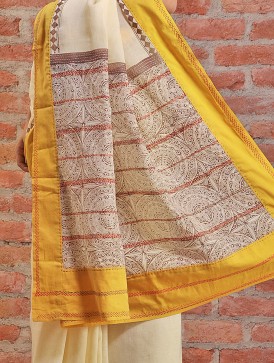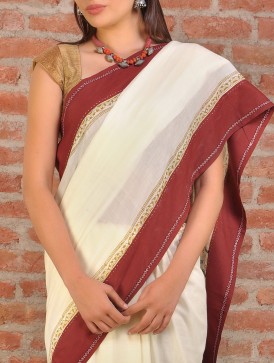Wearing a saree, especially for non-festive occasions, is such an eyebrow-raiser these days. Me thinks that is not just beauty, but even disapproval that lies in the eye of the beholder. Behenji, amma, aunty, mataji, teacherji, or madam are some of the sarcastic terms of endearment that are likely to come your way when you wear a saree. And if you happen to be approaching the hill (35+ years), sporting some middle-age spread, wearing a saree can invite a stray and tactless comment by the self-appointed fashion and trend police.
This unfortunate behenji-fication of the saree does not deter me from wearing one when I want to. Someone who loves sarees once told me “Sarees have stayed in ‘fashion’ for 2000 years. They’re not going anywhere.” And I so second that sentiment. On this happy, optimistic note I bring to you, from the state of West Bengal, a handloom delight.
F for Fuila. And no, I am not tryin’ to fool ya’. There really is a saree by this name. Though some may call it Phulia, I prefer the ‘F’ over the ‘Ph’. See I have a duty toward this alphabetical list I am trying to keep alive and without the Fulia, the F would be without a match.
The Fulia saree is hand-woven using cotton or silk yarn – simple and with little embellishment. The idea behind the Fulia is to let the fine fabric, the weave and the texture speak, hence the minimalistic style. A border, a few stripes or a smattering of a block print is all you get to see on a Fulia saree. Although I have seen the Fulia saree many times, I don’t own it, neither have I worn one. From what I have seen I can say that my wardrobe could definitely make space for one silk and one cotton Fulia saree.

A Cotton Fulia saree. Image courtesy and copyright http://www.jaypore.com

A Cotton Fulia saree. Image courtesy and copyright http://www.jaypore.com
A Fulia saree is a fine example of the illustrious Bengal hand-woven saree heritage. This saree is named after the town Fulia, in the district of Nadia 90 kilometers from Kolkatta.
The weaving heritage of Fulia is not very old. The weavers in Fulia trace their lineage back to the weavers of the famous Dhakai Jamdani of Bangladesh who settled in India at the time of partition. Some of them settled in the already rich weaving centers of Shantipur while most others settled in Fulia. A whole lot of information about Fulia and its weaving history abounds on the Web, but very little is written about the features of the Fulia saree itself.
Some of the most informative sources I recommend for further reading are this blog and this website.
How does one recognize a Fulia saree? Well, I tried hard to look for answers and found it difficult to find a concrete one. Based on what I know of these sarees by observation, I can say that these sarees do not carry Jamdani-like motifs. Their texture is coarse to look at but very fine, soft to touch because of the hand-woven characteristic. They are usually plain and available in earthy colours. They do however, look a lot like any other hand-woven cotton saree. A cotton Fulia may cost anything between rupees 1500 to 3000, whereas a silk saree may cost above rupees 6000.

A Cotton Fulia saree with block-print pallu.
Image courtesy and copyright http://www.jaypore.com

A Cotton Fulia saree.
Image courtesy and copyright http://www.jaypore.com
As I conclude this post, I feel a little unsettled that the information I have given is very little, though God knows I tried a lot of sources. My quest for information or images, as I have said before, does not end when a post is complete. I will keep looking and will update this post when I do get something good and credible. After F, it is time for G now. G for the Glorious Gadwal. Until then…
Sources:
- For the lovely images in this post, I am most grateful to www.jaypore.com who almost immediately gave me the go-ahead to use their images.
- http://bengalhandlooms.com/shantipur-fulia/
- http://artisansoffashion.tumblr.com/post/49923353065/village-weavers-of-phulia-shantipur-in-west-bengal

Awesome….. I am a huge huge sari fan…. And I so relate to what u wrote initially on people’s reaction to sari. Having said that I have had a lot of positive reactions as well or rather more positive than negative ….. But yes it is something alien for them (strangely so given it’s our national garment almost!! )….. People always wondered how could I wear a sari just like that to office, a party or for a simple walk in the park!!…. Initially they would try and take out meanings – birthday? Anniversary? Pooja hai?…. And I would be like no!! I feel like a sari today!!…. Especially when it rains I feel the drapes pull me into their soft fluid folds…..
Looking forward to more posts from you…..
Great job!!
Thank you…:)
Having born and brought up in Kolkata and being a saree lover here are a few observations. It might help you piece it together. Phulia is a place, as you pointed out, which is the home for weavers of traditional Bengal Cotton Sarees . Bengal Cotton Sarees also goes by the popular name of Tangail ( a place in Bangladesh). Post partition, Dhakai / Jamdani sarees is also woven here. As you can make out Dhakai Sarees got their name from Dhaka which must have been the birthplace of these sarees.
So, in my growing up days, my mother and aunts used to go to Phulia to get the Tangail sarees in bulk .
There is another type of traditional Bengal Cotton Saree caleed Dhanekhali again named after a place in Bengal. Dhanekhali is a particular favourite of mine. It is courser and has a typical weave at the pallu and generally a solid coloured border.
There were other varieties of Bengal Cotton which had become extinct – at least were not available in city stores. These weaves are now being revived. And all these weaves are being woven in Phulia. These weaves are sometimes courser and in striking colours.
So a Phulia saree has no identification except the fact that all of them be it Tangail, Dhoniakhali, Abir, Dhakai, Balcluchori are all sarees from Bengal
Thank you Sreerupa for a very detailed note. I acknowledge that my research has gaps and I thank readers like you who take the trouble to set it right.